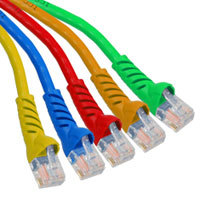Quality patch cables are vital to your networks connectivity!

Both Cat5e patch cables and Cat 6 patch cables are very popular in voice and data network cabling applications! Patch cables are used every day to connect network devices together. They also play a major role in connecting network devices directly to a network. All network devices need some type of network cable to receive the network signals they need to perform. Common devices that require a network patch cable include IP cameras, printers, routers, gaming stations, hubs, network switches, computers, and IP phones. As technology continues to grow, more and more products are being attached to a network for purposes of programming, grabbing data from another source, transferring data to another source, or for just communicating. The use of network based products is growing which means there is more and more demand for high performance network patch cables. The patch cable itself is a very simple cable. Most commonly it is just a piece up Cat5e or Cat 6 twisted pair network cable that has rj45 modular connectors on each end. The module connectors on each end allow you to connect your devices to the network. A patch cable is a simple cable but it plays a huge role on the data transfer speed and performance of your network and its network devices.
Most patch cables are made of stranded twisted pair Category 5 network cable or Cat 6 network cable. Stranded cable is much more flexible than solid cable and allows you to easily bend or twist the cable as it is dressed or installed onto your devices. The standard Cat5e cable is 350 MHz rated and the standard Cat 6 cable is 550 MHz rated. What this means is the Cat 6 cable is a bigger pipe for your data transfer, which at the end of the day means a faster network and faster data transfer speeds. Both Cat5e and Cat 6 patch cables will support high speed networks just fine. But many companies are moving to a complete Cat 6 network in preparation for the future, when the higher bandwidth may be needed. Usually the type of patch cables you use will match the network products you have installed. An example of this would be if you have a current network that is using Cat 6 cable throughout the entire network. It is a must to match all the cables and components you have installed with the Cat 6 cable. This means all the cables, keystone jacks, patch panels, and any other components of the network must be Cat 6 rated. This would apply the same if you are using a complete Cat5e solution. You network will only perform to the speed of its weakest link!
Although the central components of a patch cable seem to be very simple, patch cables are also often the most over-looked component of a network. A quality patch cable also has strain reliefs that are terminated to the cable at the same time the connectors are crimped. A strain relief is a small boot that not only protects the termination of the cable to the modular connector, but also strengthens the connection between the two. A quality strain relief actually connects to both the cable and the modular connector making the termination longer lasting. Since a patch cable is designed to plugged in and un-plugged the daily handling of a patch cable could cause them to be damaged. The strain relief give the termination added strength so the termination it never broken. The strain relief also protects the termination from dust particles that could eventually damage the connection causing the network to be compromised.
Although patch cables are very simple cable types, do not underestimate their importance. Use only high quality patch cables that are tested and guaranteed to support high speed network applications.


